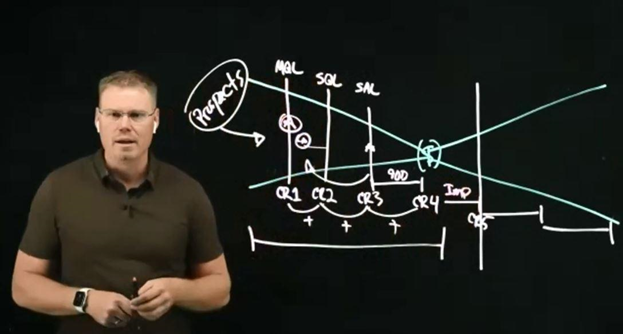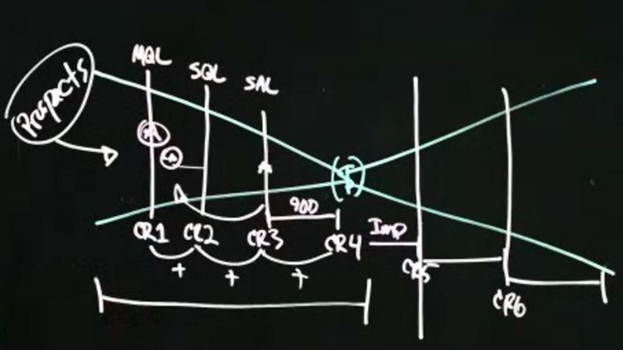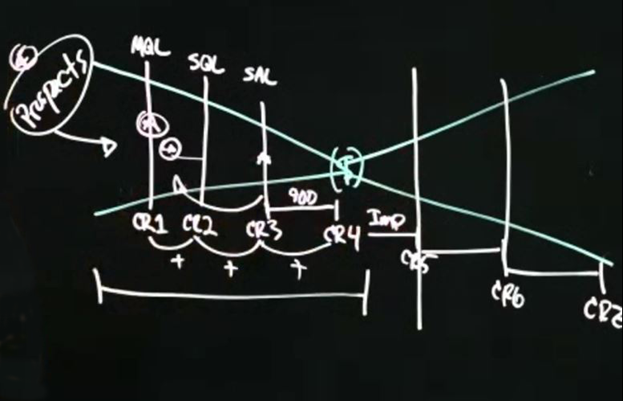On the recent bi-weekly mastermind call with SaaS experts and mentors I interviewed Ryan Cahill about the go-to-market strategy.
Ryan is passionate about helping SaaS companies design, optimize and execute their sales and marketing strategies. He spent the last decade in the SaaS world working with different industry leaders. He has also consulted for hundreds of subscription startups, executives and entrepreneurs.
Ryan talks about the science of growth and where that is going to fit with post-product market fit.
Go-to-market is the strategy that you use to acquire new customers or expand on the ones you have.
In the diagram below, the left-hand side represents the number of customers or we’ll say users in this example and across the bottom is going to be the value of your product or service and so this can be in monthly or annual recurring dollars but we will be using annual for this example.

In most organizations as the price point goes up, the number of people that can afford the product goes down.
Product Led Growth (PLG)
Let us assume that the first tier is $5,000 a year. The go-to-market strategy that most commonly applied to this is what’s generally referred to as product lead growth. You can think of platforms like zoom or slack which are apps that you can just sign up for and start using immediately, then over time, you might end up buying more licenses, you might end up using them more. Generally speaking, you’re not talking to a salesperson, you’re not talking to someone in business development. It’s generally a technical interaction from a sales motion.
Inside Sales (IS)
Once you break the $5k-$7k mark, generally you’re usually engaging with somebody, you might have a couple of questions, you might need to see a demo. This stage is traditionally referred to as inside sales. In inside sales you are looking at a product, maybe you’re doing some research on the website, you pick up the phone, you call someone, they maybe answer a few questions for you and send you a contract, but you’re engaging with some human being at that point. This generally goes to about the $15,000 mark.
2 or more stage process
At the next point you will typically engage with two or more individuals through your sales evaluation as the customer. These can be someone in business development and sales or maybe it is sales and a technical resource. The assumption is that marketing is taking place across the entire process. This illustration is just focused on the sales approach.
3 stage process
Once you get within the $30k to $50k, this stage involves at least two people and sometimes three people. Sometimes you have a business development, sales and maybe a sales engineer. Sometimes you might have some industry strategists, you might have multiple people over here. This is often a three stage process.
One to one sales
Once you get to $150k upwards which are enterprise type solutions, you are focused on one to one sales. One to one sales is where you typically have, let’s say, five accounts you’re working on and they’re all whales. It is usually a very intimate relationship and a very long sales process
Where your product or service is in the spectrum of cost of product will dictate the type of strategy you are applying.
After you have understood the strategy you need to apply for your product or service, you need to figure out how to replicate success.
Right now you need to start thinking about who the person you’re generally going to be selling to and focus your strategy on what is going to empower them the most. What’s happened over the last handful of years, is we don’t convince people to buy anymore but sometimes we think we do.
The reality is, if they’re talking to you, they had already considered doing something different. It’s really a buyer centric market. The way you want to think about your go to market is how do I help someone buy versus convince them to buy and companies that do that are very successful.
The Amazons of this world succeed because they make the customer experience so powerful and easy, you need to do that with your go to market approach as well.
While it is an oversimplification, there are only 7 metrics you need to pay attention to in order to diagnose if what you are doing is working efficiently and how to make it more efficient over time.
On the left hand of the diagram you have prospects.
Prospects
These are people that may or may not even know you exist, that you’d like to do business with. You have to figure out from a marketing standpoint, how to attract these people and get them to engage with your brand in some way such as visiting your website, attending a webinar, responding to an email and more.
MQL
The first conversion point is MQL which is a marketing qualified lead. This is a human being that has in some way expressed interest in engaging with you, it doesn’t mean they’re ready to buy but it means they are willing to engage. It could be a Contact Us form, it could be a demo request, it could be they just want to learn more, these can all be considered marketing qualified leads.

The MQL will be called conversion rate one (CR1). The MQL is a qualification metric for the performance of your marketing.
If this rate grows over time, it means you are doing a better job at targeting your customer base, and a better job of converting them to be interested to engage. If you have 1000 people on your email list, and every month 10-30 of them become leads, you now can measure how good you are at engaging them via email.
You need to measure the performance of different channels such as social media platforms.
When you engage with folks, it is important to understand why they engaged with your brand, why they became a customer and how you can find more of these people.
You need to do some deep analysis to define who it is you’re talking to, and how they want to be interacted with, and then marry that into your product or service and all your communications.
The head of sales doesn’t think in a similar way to the head of marketing, or the head of human resources or a CFO or developer, they all think differently and you need to talk differently to those audiences. A technical audience does not want flowery language, they want specifics, they want details, they want examples. A marketer on the other hand thinks about emotional things, they want to be talked to in an emotional language, so you’ have to interact differently.
One of the biggest challenges with most websites is they are self-serving, they don’t talk to the customer, they don’t talk about the customer. They don’t talk about the customers’ problems, they brag about their product and people don’t want to hear that.
Your job is to connect the dots between your audience pain and your solution.
Sales Qualified Lead (SQL)
After you have done some great marketing and increased brand awareness. Your audience is now engaged. The next step can be called two different things, a sales qualified lead or sales accepted lead.
The difference between CR1 and CR2 is now they are willing to engage in the sales process. At this point based on what you’ve said, and shared so far, someone is willing to evaluate your possible solution for their company.
If this rate is doing well then the people you are attracting will also happen to be in the market.

If the people you are attracting are not engaging, you need to go back and look at the messaging that you are doing, and figure out a way to identify when someone has a need.
When you understand how to engage the right people at the right time then the efficiency of your marketing and business development efforts will increase substantially.
Use every engagement to learn from your customer even if they don’t buy from you. What was it that got them willing to engage with you in the sales process right now? Do they have a contract expiration coming up with their existing provider? Did they have enough pain where they just couldn’t take it anymore?
Sales Accepted Lead
You can refer to the next stage as sales accepted lead or sales qualified pipeline. What this means is they are willing to engage with sales, but they are also making that decision now. Now, a lot of companies are willing to engage with sales, but they don’t actually have a project right now. You want to be very careful with your sales people as you continue to grow your company. If you’re doing sales now your time is very valuable.
If you spent a lot of time trying to sell someone, and they want to buy next summer, you wasted your time. You want to be very sensitive to say, Okay, what is the time period that you’ve learned from your existing customers? This would basically be the sales cycle.
In some cases, maybe that’s 90 days, you need to clarify at this point, that this person is willing to make a decision within 90 days?
If the answer is no, then you need to bring them back and nurture them until that time arrives.

A lot of people get distracted when someone’s like, Oh, I’m interested, interested and ready to buy or not are the same thing. You need to make sure that they are ready to buy in the timeframe that you think is reasonable for your business so that you don’t spend a lot of cycles and energy on people that aren’t willing to sign right now because you need that revenue.
Conversion Rate 4
The next conversion point CR4 is your close rate. It involves how many bought your product or service and it is a key measure of sales effectiveness.

If you have, let’s say, a $30,000 product a year, a $30,000 product, you should be closing somewhere in the neighborhood of one out of four or one out of five of these deals. If you sell a $5000 to $10,000 product, one out of five is pretty decent.
If you sell a couple thousand dollar product, you know, maybe one out of six. As you do more volume, the numbers go down a bit. If you sell an $100,000 product, you should be closing one out of three.
You got to be very, very disciplined here because a lot of time, money and energy is spent in the sales process and if you don’t actually close them, you don’t get any return.
You need to think about nurturing differently for those types of things in general nurturing. nurturing a trial should be different than nurturing someone who came through a Contact Us form or downloaded a white paper, people should be engaged in a unique way that represents really what they’re doing. Trial nurturing is often helping them see the value of the solution, whereas general nurturing is just helping them be aware of what you bring to the table.
The next thing you need to be measuring is time. How long does it take someone to engage with you in a sales motion?
How long does it take them to confirm that they actually are ready to buy now? And how long does it take for you to sell to them?
The reason is some of that now becomes your front to back sale timeframe. If you have to market nurture them for a couple weeks, if you have to engage them for a couple weeks and sell them for a couple weeks, you now know how long it takes for you to move someone through the process where you start to get money, and you can back your way out into that.
If you’re starting today, you know that about this amount of time is required before you can get your first next sale.
As you start modeling that out for your business, that’ll start to give you an indication of the kind of lead time that you need to get that revenue engine going.
There are three more things you need to pay attention to at the back of the business.
Conversion Rate 5
The first one is CR5 which is the onboarding time frame and conversion rate. Do you churn people out before they ever go live, because that gives you an indication of the experience of that process is probably not ideal.
It also gives you a really key indicator for the customer because what happens up until that point is the customer has not received any value yet?


As the buyers go through a sales process, they don’t get anything out of that. They don’t actually get value, even at the sale. They get value once the product is live and working and doing something for them and their company.
This is the implementation or onboarding process. The go live process until the customer gets up to speed using your tool.
Conversion Rate 6
The next stage is CR6 which is basically renewal. If you sell a month to month it would be every month. If it is an annual contract or multi-year contract it will be contract one to contract one.
It is the number of people that have used your product and decide to continue the relationship for a longer period of time.

Conversion Rate 7
This is the last piece and it is lifetime value. This is how many of the people that bought something bought more of it. If you have got a subscription for $1000 a month but in the next year you got them up to $1500 a month then you are doing a really good job of increasing the spend of that customer and expanding revenue through your client base.
You also need to pay close attention to the timeframes, if the implementation time starts to drift out then that potentially increases your churn risk so you need to pay attention to that.
If you’re churning out customers, that is a problem because what it may mean is you are targeting the wrong people. If you get people to buy but then they don’t experience the value, you may be offering it to the wrong audience, the wrong vertical or the wrong person.

For your SaaS company to be really successful you need to have more things to sell, if you think of salesforce or any large SaaS organization, they have a huge portfolio of things that they can sell to their client base and that is where the majority of their revenue comes from.
As you start to mature as a business, you want to start thinking about how you can get more licenses, maybe a usage fee, maybe new modules to increase revenue.
How small companies can utilize this method
Regardless of the size of your organization, you need to know these answers and you need to measure this type of transitions whether you have 20 customers or 2000 customers because if you don’t know why someone does something then you can’t replicate success and you can’t make it any better.
If you don’t know why your customer took an extra month to implement your product then it will be difficult to make the implementation better.
The biggest mistake most SaaS founders make regardless of their company size is they can’t answer this question.
Why did the last company that you sold buy from you, you need to know the answer in their words and not what you think?
If you don’t know the answer to that then it will be tough to find more of them or speak to the things that they are trying to solve.
Fortunately, nowadays there are special communities for bootstrapped SaaS founders where they can connect with other fellows founders to consider the urgent issues and get the help to accelerate growth for their SaaS business.
Ryan shares some other tips that SaaS companies can benefit from
One of the biggest dangers most small companies face is that they go too broad too fast. If you are going after everyone under the sun, it’s very difficult for you to get better, because you don’t have a sample size large enough and you don’t have enough consistency in what you are doing to know actually what’s working and what’s not.
Resources


 Must Track SaaS Metrics to Grow Your Software Startup in 2020
Must Track SaaS Metrics to Grow Your Software Startup in 2020